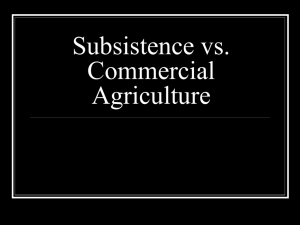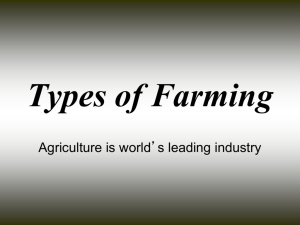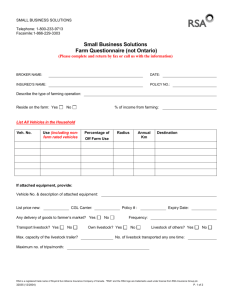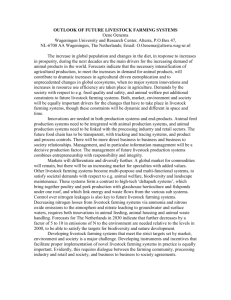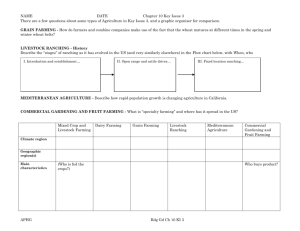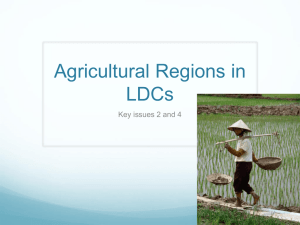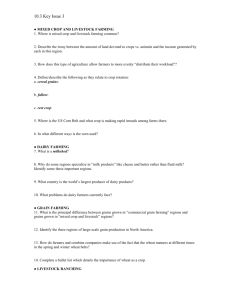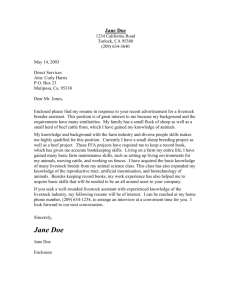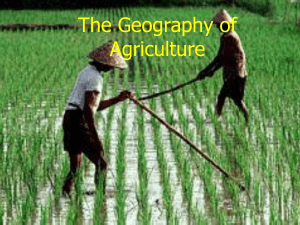SUBSISTENCE FARMING VS. COMMERCIAL FARMING
advertisement
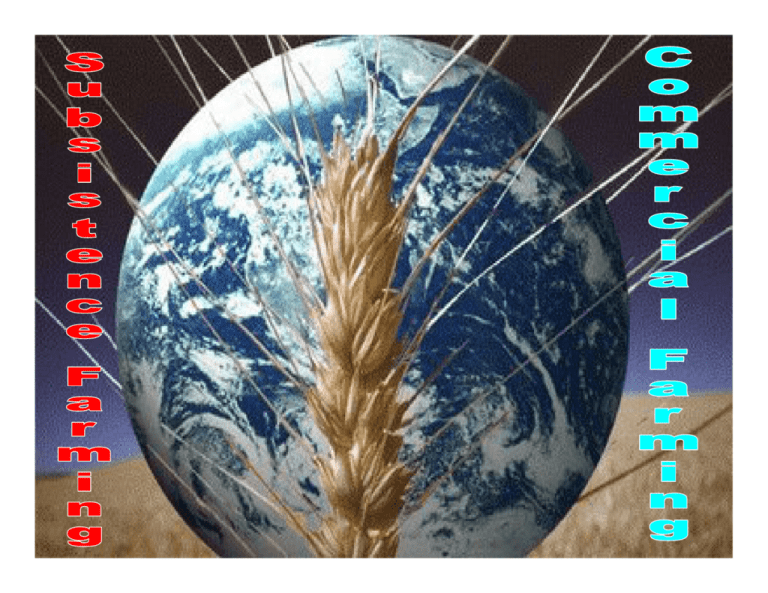
Primary Activities: Agriculture • Def. : growing crops and tending livestock, for sale or subsistence. • 10% of the total earth land is for crop farming. • Declining trend in agriculture employment in developing countries • Developed - 8% in most of W. Europe, < 3% in the US. • Agriculture is still the major components in developing countries Copyright © The McGraw-Hill Companies, Inc. Permission required for reproduction or display. Agriculture in Gross Domestic Product Figure 8.7 8-4 Source: The World Bank Fig 8.5 - average length of growing season Differences between Subsistence and Commercial Agriculture • • • • • Purpose of farming Percentage of farmers in the labor force Use of machinery Farm size Relationship of farming to other business LDC Agriculture • Shifting Cultivation • Pastoral Nomadism • Intensive Subsistence PASTORAL NOMADISM Subsistence Agriculture • Involves nearly total self-sufficiency on the part of its members. No exchange (or minimal, if any). food for themselves only. • • • No knowledge of soil chemistry, fertilizing, or irrigation, once the soil become infertile, they move to another parcel of land, clear the vegetation, turn the soil and try again. 150 to 200 million people in Africa, Middle America, tropical South America and parts of Southeast Asia. In Africa, S and E Asia, Latin America Two types – Extensive: large areas of land and minimal labor input per unit area. Production and pop density is low. – Intensive: cultivation of small landholdings through the expenditure of great amounts of labor per unit area. Production and pop density are both high. Copyright © The McGraw-Hill Companies, Inc. Permission required for reproduction or display. Subsistence Agricultural Areas Figure 8.8 8-5 Extensive Subsistence Agriculture • • • • Nomadic herding - wandering and controlled movement of livestock dependent on natural forage - the most extensive type of land use system. Sheep, goat, and camels are most common and others such as cattle, horses and yaks are important too. Animal provides milk, cheese, meat for food; hair, wool and skins for clothing; skin for shelter and excrement for fuel. Way of life is changing. Thus, nomadic herding is declining Shifting cultivation/Slash-burn • Slash-and-burn : process of preparing low fertility soils for planting. Burning add minerals to the soils, in low level of population • Shifting - rotating the fields to keep soil fertile • After burning, plant crops such as maize (corn) millet (cereal grain), rice, manioc, yam, and sugarcane Images of Shifting Cultivation Swidden Slash and burn Milpa Intensive Subsistence Systems • • • • • • • • • Half of the people of the world engaged in this activity Exchange of farm commodities Mostly in monsoon Asia. warm and moist river valleys and delta planting rice shoots by hand in standing fresh water is a tedious art (8.10) Cooler/ drier Asia - wheat and millet is planted. Rice provides 25 - 80% calories to over 2.8 billion pop. Water management is crucial to the rice production Rice Landscape - levees, reservoirs, canals, drainage channels, and terraces to extend level land to valley slopes Swine, ducks and chickens are main meat. Cattle used for labor and produce fertilizers. Farmers Market in China Fish harvesting in Thailand Paddy Rice Urban Subsistence Farming • • • • Provide 1/7 of the world food production - mostly in Asia engaged in small garden plots, backyard livestock breeding and raising fish in ponds and streams. China, Taiwan, Cuba, Kenya and many other countries residents engaged in urban subsistence farming. Advantages- convert waste from problem to resource by reducing run-off and erosion from open dumps and by avoiding costs of wastewater treatment and solid waste disposal. Examples - Sudan, Calcutta.. Disadvantage - diseases, water pollution MDC Agriculture • Mixed crop and livestock farming • Dairy farming • Grain farming • Livestock ranching • Mediterranean • Commercial gardening and fruit farming • Plantation agriculture Intensive Commercial Agriculture • • • • Characterized by high yields per unit of cultivated land Large amount of input - justified by fruits, vegetable and dairy products. Truck Farm produces wide range of vegetable and fruits with refrigerated trucks and custom packaging. (distribution of truck farm 8.17) Livestock-grain farming - growing grain for livestock feed. corn and livestock at same farm reducing transportation cost. Close to the great coastal and industrial zone markets. livestock price higher than feed, farmer convert their corn into meat on the farm by feeding it to the livestock Extensive Commercial Agriculture • • • Farmland values decline westward with increasing distance from the northeastern market of the US, but not increasing while near west coast. Climate and environmental considerations (increasing aridity and mountain ranges..) Large-scale wheat farming - requires large amount capital input. Spring wheat (Dakotas, e Montana, S Canada) winter wheat (Kansas..) Argentina in S hemisphere. Wheat is the most grain production in the world Livestock ranching - oriented to the urban market of industrialized countries. Confined to areas of European settlement., Caused destruction of tropical rain forests in Central America and the Amazon basin due to expanded cattle ranching. (in land with low quality, low pop density, and require low labor) Special Crops - mostly due to climate factor • • Mediterranean agriculture - grapes, olives, oranges, figs, vegetables and similar commodities - needs warm temp. all year round plus summer sunshine. Summer drought and winter rain, irrigation system is needed. Plantation crops - foreign to the areas – tea in India and Sri Lanka, jute in India and Bangladesh, rubber in Malaysia and Indonesia, cacao in Ghana and Nigeria, can sugar in Cuba...., coffee in Brazil and Colombia, banana in central America. – Most plantation in coastal area, easy for export. Copyright © The McGraw-Hill Companies, Inc. Permission required for reproduction or display. Ranching and Crop Agriculture Figure 8.21 8-12 Iowa Corn Storage contract harvesters Indonesia rubber plantation worker Copyright © The McGraw-Hill Companies, Inc. Permission required for reproduction or display. Relative Value per Acre Figure 8.18 8-10 Source: Statistical Abstract of the United States. Copyright © The McGraw-Hill Companies, Inc. Permission required for reproduction or display. Agricultural Regions of No. America Plantation Agriculture •Large-scale, specialized production of one tropical or sub-tropical crop •Dual economy •Export to developed world Copyright © The McGraw-Hill Companies, Inc. Permission required for reproduction or display. Principal Wheat-Growing Areas Figure 8.20 8-11
